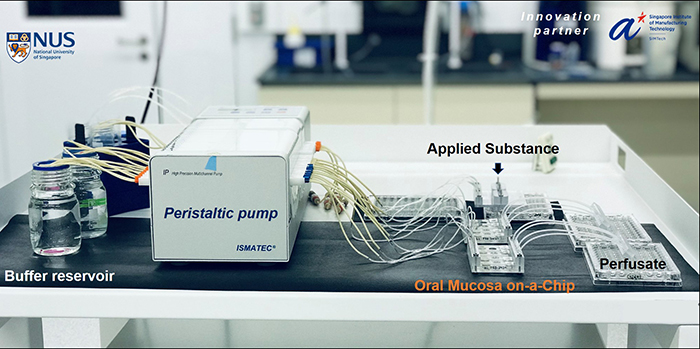News
Faculty of Dentistry graduate researcher takes home top prize
In the recent IADR DASCR SEPTODONT YOUNG INVESTIGATOR PRIZE FOR INNOVATION, Mr Muniraj Giridharan (Giri), Currently pursuing his graduate research program in the Discipline of Oral Sciences, Faculty of Dentistry, NUS was awarded the IADR DAR Septodont - Young Investigator Prize for Innovation for his project titled ‘Multi-Chambered, Microfluidic Oral Mucosa-on-a-Chip for In-Vitro Evaluation of Lidocaine Permeation’. Currently pursuing his graduate research program in the Discipline of Oral Sciences, Faculty of Dentistry, NUS we caught up with Giri to discuss his latest achievement.

Multichambered Microfluidic Oral Mucosa-on-a-chip complete laboratory set-up
Q: What inspired you to become a dental researcher?
Giri: As a bioengineer, I have a deep-rooted interest in interdisciplinary research. The PhD programme offered under my supervisor Dr. Sriram Gopu at Faculty of Dentistry offers the perfect blend of engineering and biology. This also helps me to apply my skills as an bioengineer on solving problems in Dentistry and also learn new skillsets related to the fields of microfluidics and growing human tissues in the lab. Thereby I embarked my journey as a dental researcher.
Q: How did you arrive at your research topic and what were some of the challenges you had to overcome?
Giri: Conventional evaluation of materials and drugs used in dentistry are performed using non-human models (typically using samples from pig). This raises challenges on the prediction and relevance to humans. The key challenges for using human tissues was the limited availability and ethical issues in obtaining them. Hence, we focussed on developing a miniaturised microfluidic-based system that would help reduce the size of samples required for the testing. In parallel, we focused on developing a method to grow oral mucosal tissues in the lab that would help us overcome availability & ethical issues related to use of human samples and also avoid use of animals in research. So, in this work we used the miniaturised microfluidic device and lab-grown oral mucosal tissues to develop the oral mucosa-on-a-chip. We all know pain is the greatest fear from a patient’s perspective. So, as a proof-of-concept, we used the oral mucosa-on-a-chip to test the permeation of dental anaesthetics through oral mucosa. Understanding drug permeation can eventually help the development of novel dental anaesthetics that can be delivered topically in a painless manner without an injection. As this research involves coalition of engineering and biological fields, we encountered various challenges. But these challenges also gave us an opportunity to develop and optimize our system.
Q: Having won the IADR DASCR SEPTODONT YOUNG INVESTIGATOR PRIZE FOR INNOVATION, what are your plans moving forward, and will you be submitting another project for consideration?
Giri: Happy to receive this award and appreciate IADR’s recognition of our work. We’d be glad to participate in the future, to represent our faculty in the upcoming conference and events. In the next phase, we will be expanding the utility value of the oral mucosa-on-a-chip by extending its use for various applications like safety/toxicity tests, drug delivery, and oral microbiome studies
Q: Is there anyone you would like to thank as part of your win?
Giri: : I would like to thank my supervisor Dr. Sriram Gopu, my co-supervisor Dr. Wu Ruige(from SIMTech), our collaborator Dr. Alberti Massimo (from SIMTech) and other team members for their continued support.

